Lucid Hydra 200: Vendor Agnostic Multi-GPU, Available in 30 Days
by Anand Lal Shimpi on September 22, 2009 5:00 PM EST- Posted in
- GPUs
A year ago Lucid announced the Hydra 100: a physical chip that could enable hardware multi-GPU without any pesky SLI/Crossfire software, game profiles or anything like that.
At a high level what Lucid's technology does is intercept OpenGL/DirectX commands from the CPU to the GPU and load balance them across any number of GPUs. The final buffers are read back by the Lucid chip and sent to primary GPU for display.
The technology sounds flawless. You don't need to worry about game profiles or driver support, you just add more GPUs and they should be perfectly load balanced. Even more impressive is Lucid's claim that you can mix and match GPUs of different performance levels. For example you could put a GeForce GTX 285 and a GeForce 9800 GTX in parallel and the two would be perfectly load balanced by Lucid's hardware; you'd get a real speedup. Eventually, Lucid will also enable multi-GPU configurations from different vendors (e.g. one NVIDIA GPU + one AMD GPU).
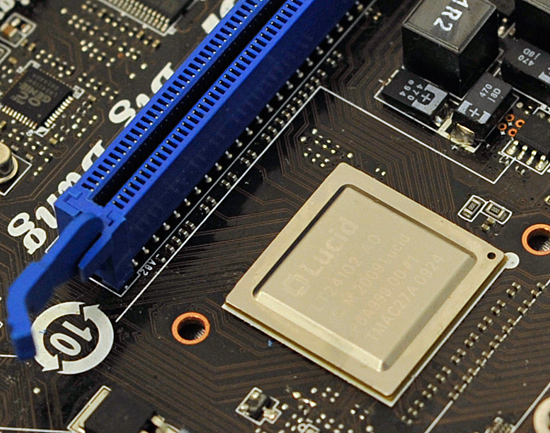
At least on paper, Lucid's technology has the potential to completely eliminate all of the multi-GPU silliness we've been dealing with for the past several years. Today, Lucid is announcing the final set of hardware that will be shipping within the next ~30 days.
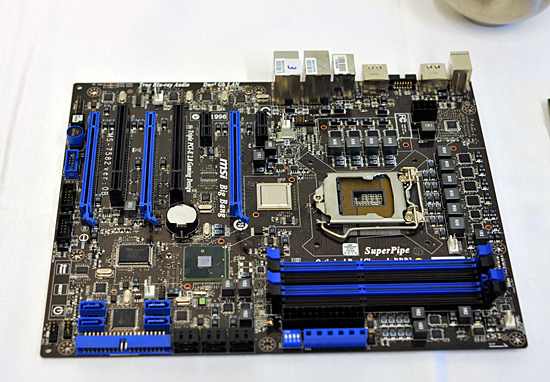
The MSI Big Bang, a P55 motherboard with Lucid's Hydra 200
It's called the Hydra 200 and it will first be featured on MSI's Big Bang P55 motherboard. Unlike the Hydra 100 we talked about last year, 200 is built on a 65nm process node instead of 130nm. The architecture is widely improved thanks to much more experience with the chip on Lucid's part.
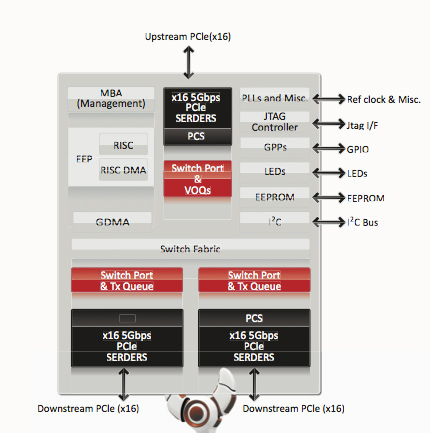
There are three versions of the Hydra 200: the LT22114, the LT22102 and the LT22114. The only difference between the chips are the number of PCIe lanes. The lowest end chip has a x8 connection to the CPU/PCIe controller and two x8 connections to GPUs. The midrange LT22102 has a x16 connection to the CPU and two x16 connections for GPUs. And the highest end solution, the one being used on the MSI board, has a x16 to the CPU and then a configurable pair of x16s to GPUs. You can operate this controller in 4 x8 mode, 1 x16 + 2 x8 or 2 x16. It's all auto sensing and auto-configurable. The high end product will be launching in October, with the other two versions shipping into mainstream and potentially mobile systems some time later.

Lucid wouldn't tell us the added cost on a motherboard but Lucid gave us the guidance of around $1.50 per PCIe lane. The high end chip has 48 total PCIe lanes, which puts the premium at $72. The low end chip has 24 lanes, translating into a $36 cost for the Hydra 200 chip. Note that since the Hydra 200 has an integrated PCIe switch, there's no need for extra chips on the motherboard (and of course no SLI licensing fees). The first implementation of the Hydra 200 will be on MSI's high end P55 motherboard, so we can expect prices to be at the upper end of the spectrum. With enough support, we could see that fall into the upper mainstream segment.
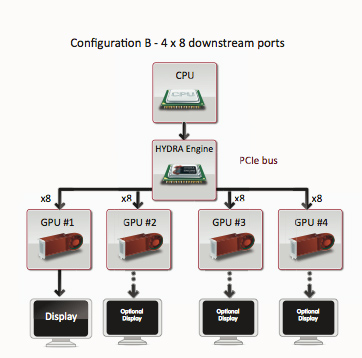
Lucid specs the Hydra 200 at a 6W TDP.
Also unlike last year, we actually got real seat time with the Hydra 200 and MSI's Big Bang. Even better: we got to play on a GeForce GTX 260 + ATI Radeon HD 4890 running in multi-GPU mode.
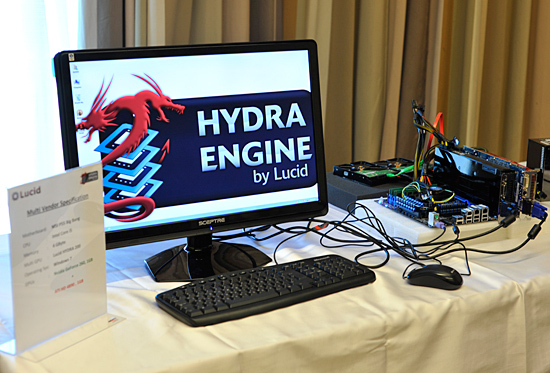
Of course with two different GPU vendors, we need Windows 7 to allow both drivers to work at the same time. Lucid's software runs in the background and lets you enable/disable multi-GPU mode:

If for any reason Lucid can't run a game in multi-GPU mode, it will always fall back to working on a single GPU without any interaction from the end user. Lucid claims to be able to accelerate all DX9 and DX10 games, although things like AA become easier in DX10 since all hardware should resolve the same way.
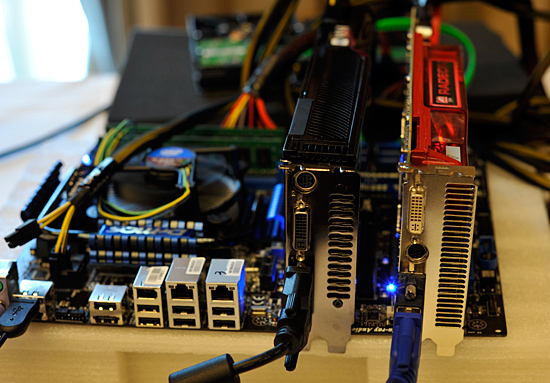
NVIDIA and ATI running in multi-GPU mode on a single system

There are a lot of questions about performance and compatibility, but honestly we can't say much on that until we get the hardware ourselves. We were given some time to play with the system and can say that it at least works.
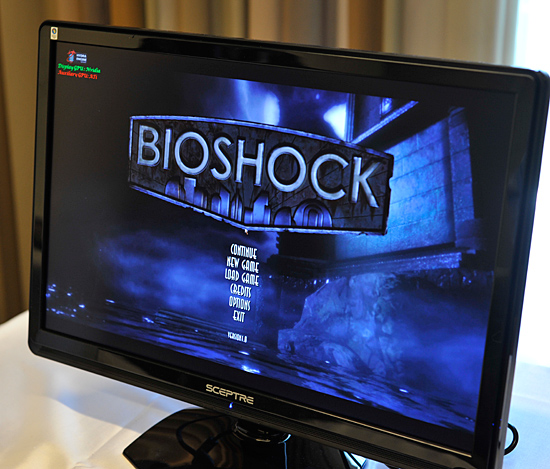
Lucid only had two games installed on the cross-vendor GPU setup: Bioshock and FEAR 2. There are apparently more demos at the show floor, we'll try and bring more impressions from IDF later this week.










94 Comments
View All Comments
petteyg359 - Tuesday, September 22, 2009 - link
Both of you grow up and learn to use the proper tense of misled, please.Dante80 - Tuesday, September 22, 2009 - link
...until the fat lady sang...XDI'd written this off, thinking that it was nothing more than smoke and mirrrors...from the looks of it, I'm wrong..and also glad about it...^^
A couple of questions:
1> Will we be able to see this in AMD systems in the future, or is it an intels' exclusive?
2> Regarding the optional monitors in the pics, would this work with eyefinity? (I assume it does)
3> If this catches on (and it will if it delivers linear graphic acceleration without latency), what would this mean for driver development in nvidia and ATI? I know hydra is supposed to be driver agnostic, but
a> It would render most sli-Xfire work as an exercise in futility. (?)
b> Drivers could be optimized to take advantage of it. (?)
F3R4L - Thursday, September 24, 2009 - link
Well, seeing how Intel is an investor in the company I would take a gamble and say it will be Intel only...Mumrik - Tuesday, September 22, 2009 - link
Oh my!prophet001 - Tuesday, September 22, 2009 - link
quit playinyacoub - Tuesday, September 22, 2009 - link
Interesting but I wonder how much latency it adds to the process and how that impacts FPS games where low input latency is crucial.andrihb - Tuesday, September 29, 2009 - link
This is my biggest worry. Latency is often a problem for me as it is.Ben90 - Tuesday, September 22, 2009 - link
Im sure the latency isnt going to be that big of a problem...remember all the hype about 1156 having an integrated PCI-e controller and the massive frame rates from how the latency is going to be so low.Howabout 1336 vs 1156; 1336 has an IMC while 1156 doesnt, yet memory performance is basically the same if both are run on dual channel (yea; 1336 is slightly faster dual channel, but its like less than 1%)
adam92682 - Wednesday, September 23, 2009 - link
1156 has an IMC.sc3252 - Tuesday, September 22, 2009 - link
I don't remember any "massive" hype, but of course I am don't buy much into hype until I see something working. I really don't think this will turn into much. I bet a few people are going to buy it like those killer nic, and maybe there will be a slight speed increase over just using your one nvidia 8800gt compared to running a 8800gt and a 3870, but I think there wont be much benefit in Lucid Hydra over SLI or crossfire.Of courses all this speculation can end in 30 days, right? Of course though if it sucks they will say there is a driver issue that needs to be sorted out...